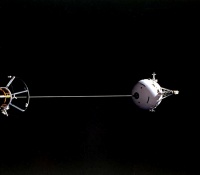TSS-1
From The Space Library
 | |
| Organization | Piano Spaziale Nazionale of CNR (Italy),NASA-Office of Space Science Applications (United States) |
|---|---|
| Mission type | Engineering,Space Physics |
| Launch date | June 26, 1992 |
| Launch vehicle | STS-46 |
| Carrier rocket | Space Shuttle |
| Launch site | Cape Canaveral, United States |
| COSPAR ID | TSS-1 |
| Mass | 518.0 kg |
| Experiments | Here |
| Alternate Names | Tethered Satellite System 1 |
| Additional Information | Here |
| PDMP Information | Here |
| Telecommunications Information | Here |
| Data Collection | Here |
The Tethered Satellite System (TSS) consists of a satellite, a conducting tether, and a tether deployment/retrieval system to be flown on the Space Shuttle. The objectives of the TSS-1 mission were to: (1) verify engineering performance of the Tethered Satellite System (TSS); (2) determine and understand the electro-magnetic interaction between the tether/satellite/orbiter system and the ambient space plasma; (3) investigate and understand the dynamical forces acting upon a tethered satellite; and, (4) develop the capability for future tether applications on the Shuttle and Space Station. The TSS released a satellite while remaining attached to a reel in the orbiter payload bay. This mission was intended to demonstrate control of the satellite during deployment, aerodynamic stability at flight altitude, and the ability of the system to collect meaningful scientific data and to return the data to the Orbiter, and then to the Payload Operations Control Center (POCC). The satellite was to be deployed 20 Km (12.5 miles) above the Orbiter. The deploying equipment consisted of a Spacelab pallet, a reel for tether deployment, an extendible/retractable boom for initial deployment and final retrieval of the satellite, an electrical power and distribution subsystem, a communications and data management subsystem, and a tether control capability. A separate support structure carried science instrumentation. The spherical satellite was 1.6 meters in diameter, with the upper hemisphere containing some of the scientific payload, and the lower hemisphere containing the support equipment. The satellite contained cold gas (nitrogen) thrusters used for deployment, retrieval, and attitude control. The 2.54 mm diameter conducting tether cowas constructed using Kevlar and Nomex with 10 strands of 34 AWG copper wire and a Teflon sheath. NASA was reponsible for the TSS deployer and systems integration, and Italy for building the satellite. Five investigations from Italy and five from the USA were selected for the first mission. Because of a technical problem (a protruding bolt) the tether could only be released to about 840 feet. A reflight of the tether system (TSS-1R) is now scheduled for February 1996.
